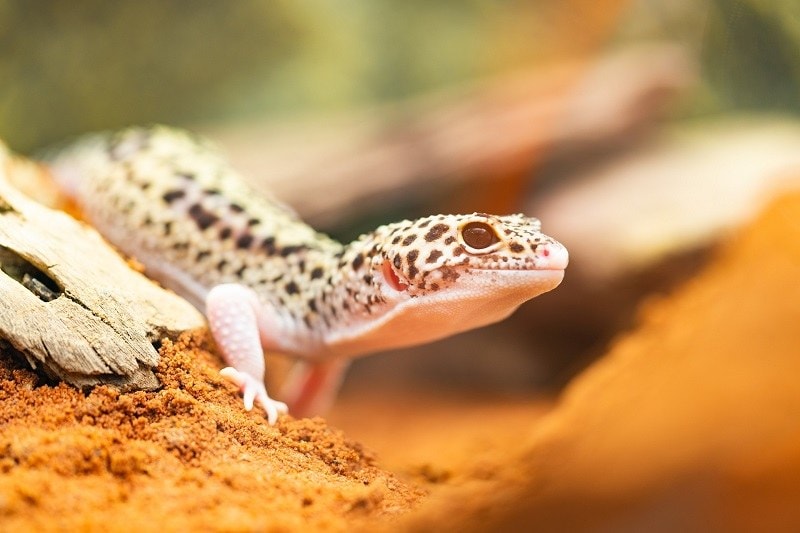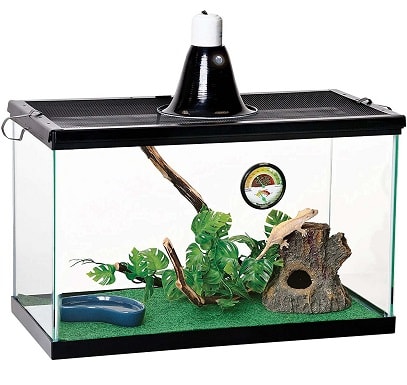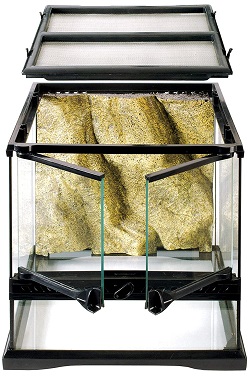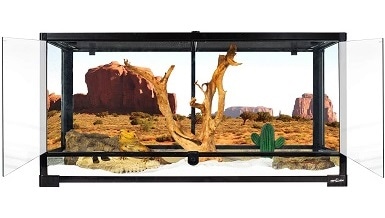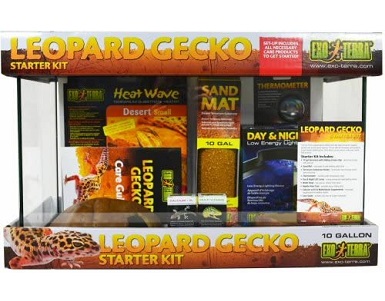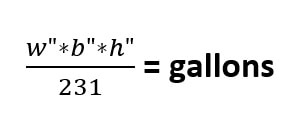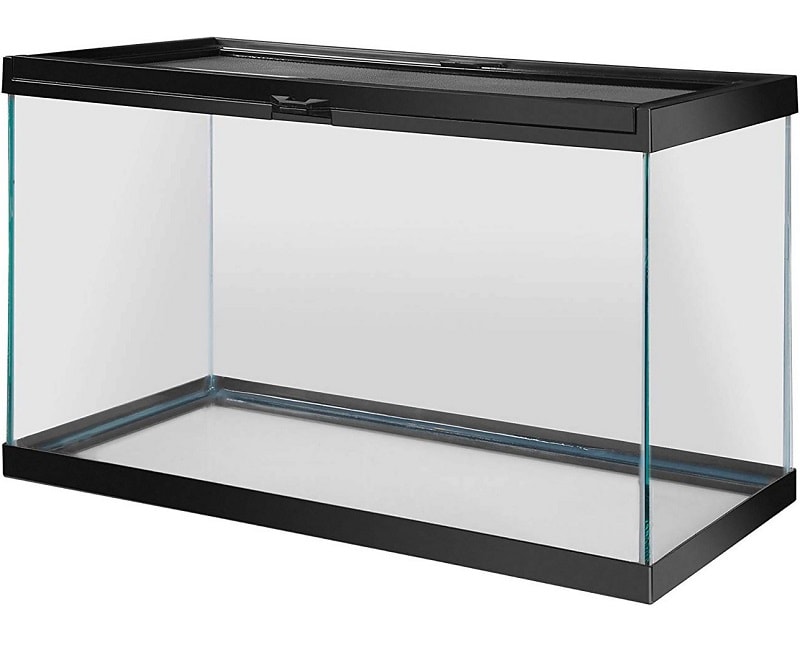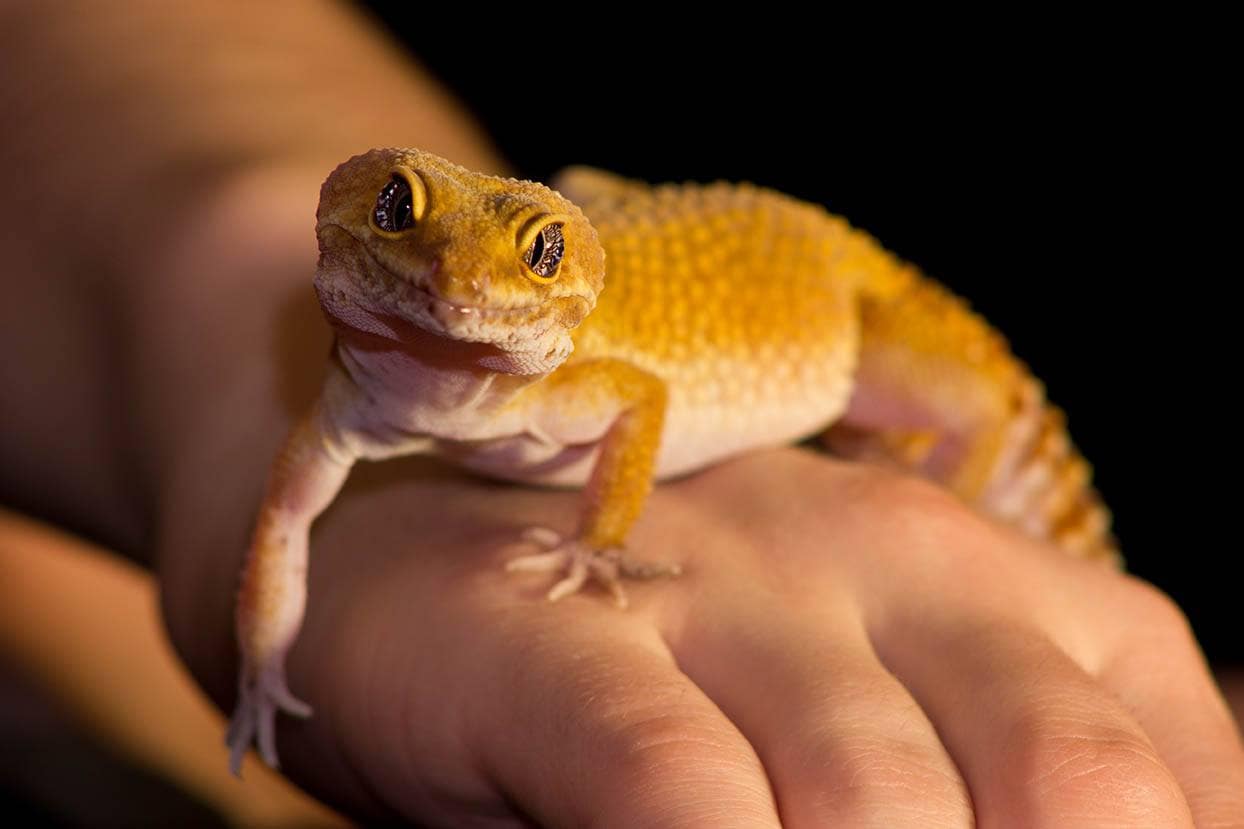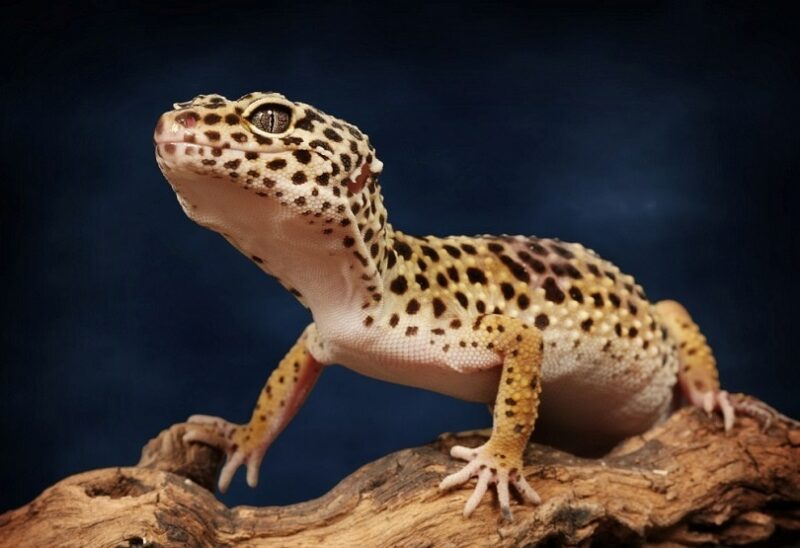Docile and easy to manage compared to other lizards, the leopard gecko is considered a great reptilian pet, especially for first-time owners. With that said, you do need to provide a balanced and species-appropriate diet. You will also need to manage heat and moisture levels, offer hides, and plenty of space and floor space for these terrestrial lizards.
Providing the right habitat and environment first means choosing an appropriate terrarium. The vivarium should be an appropriate size for your little ones. Choose the biggest size you can, because the leo cannot have too much space, but do make sure that it is tailored to the needs of the gecko.
These floor-bound creatures prefer floor space to height, and you will need the fixtures and fittings that enable you to provide heating, lighting, and moisture while making it easy to get in and clean the tank out.
To help you find an appropriate vivarium, you can find reviews of the five best leopard gecko habitats we found as well as a guide to whittle down your own choices.
Quick Glance at the Winners of 2024
| Image | Product | Details | ||
|---|---|---|---|---|
| Best Overall |

|
Zilla Tropical Reptile Terrarium |
|
Check Price |
| Best Value |

|
Exo Terra Allglass Terrarium |
|
Check Price |
| Premium Choice |

|
REPTI ZOO Reptile Glass Terrarium |
|
Check Price |

|
R-Zilla SRZ100011868 Fresh Air Screen Reptiles Habitat |
|
Check Price | |

|
Exo Terra Leopard Gecko Starter Kit |
|
Check Price |
The 5 Best Leopard Gecko Habitats
1. Zilla Tropical Reptile Terrarium — Best Overall
This basic setup is an inexpensive 10-gallon tank with everything you need to provide suitable lighting and heating for a gecko. The tank measures 20” x 10” x 12” and is considered suitable for snakes, geckos, and other young reptiles.
It includes a blue daytime bulb and heating mat, carpet-substrate and it has handy temperature and humidity gauges. However, the set does not include a water bowl, hide, or plants, although they are shown in the image.
Getting the right temperature and humidity is vital to the health of your lizard. Even if the temperatures are not too extreme to be life-threatening, a few degrees below ideal could be low enough to force your gecko into brumation sluggishness, while a little too hot can make it more of a challenge to properly shed their skins.
The carpet substrate prevents odors and is non-edible. It is also easier to clean and clear out than alternative substrate types.
The setup is very competitively priced and it does offer all of the basics required, but the tank is only really suitable for juveniles because it is a 10-gallon tank and the smallest size for adult geckos should be 20 gallons.
2. Exo Terra Allglass Terrarium — Best Value
This tank is a 12-inch cube, which means that it is approximately a 7.5-gallon tank. This should be big enough for a leopard gecko up to around 12 months of age, when it will need a larger tank with more floor space. The tank has a raised bottom, which makes it easy to fit a substrate heater. The tank is glass and has front-opening doors that make it easy to get in and clean the vivarium out.
Although this is more expensive than the Zilla above, despite being smaller, it is made from glass which is tougher, easier to keep clean, and retains heat better than the plastic of the Zilla. It is an all-around better choice of material.
When compared to other glass tanks, the Exo Terra Allglass Terrarium is actually cheaper and is one of the best leopard gecko habitats for the money. Apart from the tank itself, though, you only receive a rock background, and you will need to invest in everything including lighting, heating, bowls, and substrate.
There have been some cases of smaller reptiles escaping through the vents in the back of the tank, however, and while the terrarium is good quality, you do not get anything else you need.
3. REPTI ZOO Reptile Glass Terrarium — Premium Choice
The Repti Zoo Reptile Glass Terrarium is larger than the previous terrariums, measuring 36” x 18” x 24”. There are two dimension choices, and this horizontal design is the one that is better suited for leos because it offers more floor space. It is an expensive tank and it comes flat packed. This does mean some construction is required, but it is easy to put up, and because it comes flat packed, it reduces the chances of you opening a pile of cracked glass.
The terrarium has a raised, waterproof base, and it has a host of openings and secure vents. The top section of the front of the tank can be opened and securely closed, which is handy for easy cleaning, and there are sealable vents for wires and cables.
Although this tank does appear much more expensive than the first two, it is a 30-gallon tank, which more than meets the minimum size requirements for a mature gecko.
The tank is expensive, and there are issues with some of the parts, including the doors and the seals for the wire holes, not aligning or fitting quite right, but it is a good size, is configured well for getting in and cleaning, and the glass is decent quality.
4. R-Zilla SRZ100011868 Fresh Air Screen Reptiles Habitat
Measuring 18” x 12” x 20”, this is approximately an 18-gallon tank which is only slightly smaller than the minimum recommended size for a gecko habitat. It is made of an aluminum frame with a black screen mesh that the manufacturer claims is escape-proof.
It is designed to offer fresh air living for its inhabitants so it will require a lot of temperature and humidity management unless you live in tropical conditions. Regular misting sprays throughout the day, and the addition of multiple heat lamps to maintain a decent air temperature, will help ensure that you can offer your gecko the appropriate heating and living conditions.
It does have a PVC bottom, which is water-resistant but not waterproof. It has a cord access port that allows the insertion of wires and the closing of the port to prevent your reptile from escaping. It is easy to assemble, but it is not the toughest or most robust of terrariums, and it will pose a number of heating and humidity difficulties for most gecko owners.
While the R-Zilla does just about meet the minimum size requirements for an adult gecko, something a little larger would be more beneficial.
5. Exo Terra Leopard Gecko Starter Kit
The Exo Terra Leopard Gecko Start Kit is a starter kit for juvenile geckos. It is a 10-gallon tank, which means that you will have to buy something larger, ideally a 20-gallon tank, when your leo reaches about one year old.
Although the kit claims to include everything needed to get started, it doesn’t offer adequate tank heating. It includes a heat mat, but this only heats the sleeping area and at ground level. The bulb is only an LED light, too, so neither of these provides adequate air heating to keep your gecko happy and healthy. The tank is sturdy and easy to clean, comes with a sand substrate mat that covers the whole base of the tank.
The set does also include the light and the heat mat, and it has a thermometer, which is an essential piece of kit in a gecko terrarium, although you will also need some method of measuring humidity, which is not provided.
You also do not receive water bowls, you only receive one hide rather than the two that are usually advised, and you will need an additional bowl. Considering the price of the starter kit, you will still need to spend quite a lot more money to get everything you need.
Buyer’s Guide: Choosing the Best Leopard Gecko Habitats
The leopard gecko is a ground-dwelling lizard that usually lives in tropical conditions. They can live as long as 20 years and grow 10 inches from nose to tail. They are nocturnal, which means that you won’t be seeing a lot of them during the day, and while we typically think of geckos as having sticky fingers that make them highly capable climbers, the leopard gecko does not have these and so is not a particularly skilled climber.
They are easier to care for than a lot of other species of lizards. They are also one of few to have eyelids, and they have some very unique characteristics and behaviors. This combination makes them a good choice of pet, even if you have never owned or cared for a lizard before.
What You Need
When considering a leopard gecko as a pet, you need to meet its dietary requirements, of course, but you also need to provide your leo with a suitable place to live. Typically referred to as a vivarium, terrarium, or tank, their habitat needs to include additional features like UVB lights, heat lamps, heat mats, suitable substrate, bowls for water and some food, and hides, as below.
Terrarium
The terrarium is the tank itself. It can be made from plastic or glass. Glass is usually considered the stronger and longer-lasting choice while its thermodynamic properties mean that it is easier to keep heat within a glass terrarium than a plastic one, so it is easier to provide the living conditions that your little lizard requires. However, glass is heavier, more expensive, and can be more difficult to put up and take down.
Terrarium Size
Leopard geckos, unlike a lot of other species of gecko, prefer horizontal space, rather than vertical. The species doesn’t really climb, but may find privacy in plants, behind rocks and logs, and in the hides that you provide. For a young, juvenile, leopard gecko, a 10-gallon tank is considered adequate. However, by the time the lizard reaches maturity, it will benefit from a larger, 20-gallon tank. Rather than buying a replacement tank when your gecko reaches maturity, it may be more financially viable and practical to start with a larger tank.
To calculate how many gallons in a tank, use the following calculation:
So, a tank like the Zilla Tropical Reptile Terrarium which measures 20” x 10” x 12” would have a capacity of:
Heat Mat
The aim of any terrarium setup is to mimic the natural conditions in which your lizard would live. Your leo would lie on a rock to rest, and because the rock would have been sitting in the hot sun, it would be warm. Placing a heat mat under a section of their substrate mimics this.
The heat mat should not be so hot as to scorch your gecko’s belly but should be warm enough to heat the temperature of the substrate above.
Substrate
Substrate is the material that is placed on the ground of the terrarium and on which your lizard will walk, sit, lay, and walk around on. Again, it should mimic the natural material on which geckos would reside in the wild. This means that the substrate should be similar to semi-arid desert conditions. Common options include sand, while a more convenient option that is easier to manage and maintain is a substrate carpet.
UV/UVB Light
There has long been debate over whether leopard geckos require UVB light.
One thing is for sure, and that it is your gecko will thrive if you do provide him with adequate levels of UVB. One of the most important jobs that UVB does is to synthesize vitamin D which, in turn, enables your gecko to digest and utilize the calcium that they get in their diet. Calcium not only ensures strong bones, teeth, and claws, but it also aids in good immune strength and has a host of other physiological benefits.
It is possible to provide a healthy life for a gecko, without UVB lighting, but you need to follow a very specific and somewhat challenging feeding plan and diet. It is easier and more effective to use a UVB light. Ideally, these should be 5%–6% UVB lights, which provide enough for your gecko and should be placed high and towards one end of the terrarium so that you offer a UV gradient.
Water Dish
The leopard gecko doesn’t drink a lot of water and can go 24 to 48 hours without any water at all. With that said, you should provide a shallow water bowl in their tank, that always contains fresh water. This will more than meet their daily water requirements and ensure that they can drink whenever they want to.
Two Hides
A hide offers your reptile the chance to do exactly that. It will hide into the hide to sleep, whenever it feels threatened or stressed, which hopefully will be very rarely if at all, and just for a bit of relaxation.

You can make your hides from cardboard boxes, although you must ensure that they won’t harm your gecko in any way.
You can also create hide areas using logs and items like plant pots.
Alternatively, buy commercial hides, and consider offering a dry hide and a moist hide for the best possible living conditions. You can even offer a third, cool hide, where your Leo goes to cool down when too hot.
Thermometer
The terrarium should be heated in a way that it is warmer at one end than the other. The temperature should range from around 77°F to 83°F and there should be a 93°F basking area in the hot end. Use heat lamps to achieve the desired air temperature, and ensure that you have reliable thermometers to place at either end of the tank to measure the temperatures accurately.
Humidity Gauge
Leopard geckos originate from semi-arid desert regions, where it is quite dry. As such, your gecko will want a vivarium with humidity between 30% and 40%. Measure this with a humidity gauge or hygrometer. If you need to reduce humidity, try removing live plants or reducing the size of the water bowl and, therefore, the amount of water in the tank. Do the reverse if you need to increase humidity levels.
Conclusion
The leopard gecko is an intriguing reptile pet and one that requires less care than alternative lizard breeds, but you do need to ensure that they have a healthy diet, access to fresh water, and a suitable habitat that includes everything from basking areas to hides and water bowls.
There are a lot of options out there, including both PVC and glass vivariums, but we found that the Zilla Tropical Reptile Terrarium is an affordable and good-quality option for young leopard geckos while the Exo Terra Allglass Terrarium is another good option for juveniles because it is made from glass, it is tougher and more durable than the plastic alternatives.
Hopefully, our reviews and buying guide have helped you determine which is the best habitat for your little leopard gecko.
Featured Image: torstensimon, pixabay
